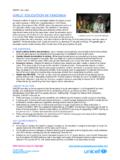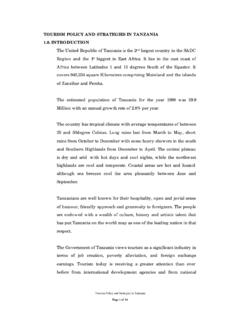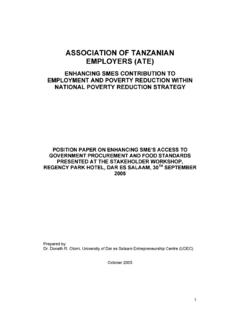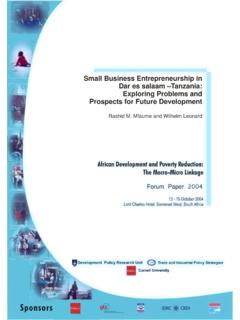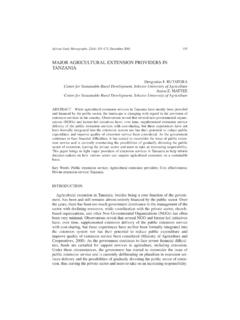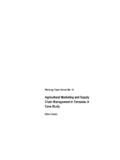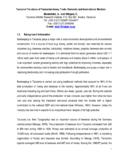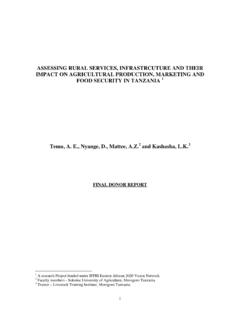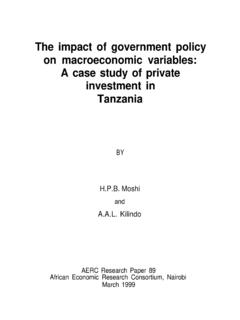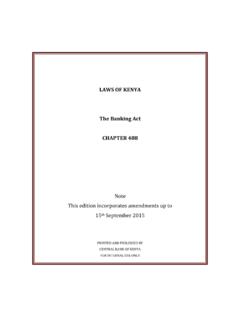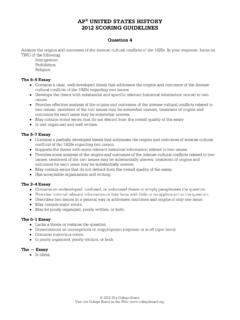Transcription of Tanzania’s Economic Reforms— and Lessons Learned
1 A case study from Reducing Poverty, Sustaining Growth What Works, What Doesn t, and Why A Global Exchange for Scaling Up Success Scaling Up Poverty Reduction: A Global Learning Process and Conference Shanghai, May 25 27, 2004 Tanzania s Economic Reforms and Lessons Learned Anna Muganda The findings, interpretations, and conclusions expressed here are those of the author(s) and do not necessarily reflect the views of the Board of Executive Directors of the World Bank or the governments they represent. The World Bank cannot guarantee the accuracy of the data included in this work. Copyright 2004. The International Bank for Reconstruction and Development / THE WORLD BANK All rights reserved. The material in this work is copyrighted. No part of this work may be reproduced or transmitted in any form or by any means, electronic or mechanical, including photocopying, recording, or inclusion in any information storage and retrieval system, without the prior written permission of the World Bank.
2 The World Bank encourages dissemination of its work and will normally grant permission promptly. Abbreviations and Acronyms BEST Business Environment Strengthening in Tanzania BFIA Banking and Financial Institutions Act BoT Bank of Tanzania CCM Chama Cha Mapinduzi (Tanzanian political party) CEO chief executive officer cph (container) crane per hour CPI Corruption Perception Index EAGER Equity and Growth through Economic Research EIU Economist Intelligence Unit ERP Economic Reform Program ESAF Enhanced Structural Adjustment Facility ESRF Economic and Social Research Foundation FACEIT Front Against Corrupt Elements In Tanzania FDI foreign direct investment GDP gross domestic product HBS Household Budget Survey HIPC Heavily Indebted Poor Country HSDP Health Sector Development Program IMF International Monetary Fund IMG Independent Monitoring Group IPC Investment Promotion Center IRT Investors Round Table ITN insecticide-treated net MDG Millennium Development Goal MoEC Ministry of Education and Culture MTEF Medium-Term Expenditure Framework NBC National Bank of
3 Commerce NESP National Economic Survival Program NIPPA National Investment Promotion and Protection Act NMB National MicroFinance Bank OPG Open General License PSRC Parastatal Sector Reform Commission PEDP Primary Education Development Plan PER Public Expenditure Review PRGF Poverty Reduction and Growth Facility REPOA Research on Poverty Alleviation SACCO Savings and Credit Cooperative societies SAP Structural Adjustment Program SP sulfadoxine pyrimethamine TACAIDS Tanzania Commission on AIDS TBL Tanzania Breweries Limited TIC Tanzania Investment Center TSh Tanzanian shilling UDS University of Dar es Salaam USAID United States Agency for International Development TANZANIA S Economic REFORMS AND Lessons Learned iExecutive Summary Having experienced a steady Economic decline in the late 1970s and a financial crisis in the early 1980s, Tanzania formally adopted an Economic recovery program in 1986.
4 It has since pursued reforms and made significant achievements: macroeconomic stability has been achieved and a wide range of structural reforms completed. Gross domestic product (GDP) growth per annum averaged percent during this period, reversing per capita income decline experienced in the decade before 1986. The growth in per capita income led to a considerable decline in the level of poverty. The long-term poverty trend has been declining for most of the post 1986 period, as indicated by various poverty studies conducted between 1976 and 1996. The studies indicate that the post-1984 period in Tanzania was marked by an overall improvement in real incomes: a 1996 by Ferreira study found that poverty (defined as the number of households below the basic needs poverty line) declined by approximately 22 percent between 1983 and 1991. Despite the setbacks on the macroeconomic policy front between 1991 and 1994, when poverty rose by approximately 11 percent, the most recent (2000 01) household budget survey confirms that there was a sustained decline in poverty over the entire decade.
5 The survey findings show that as per capita income accelerated, after the reform progress was reinforced in 1995, poverty is estimated to have declined by approximately 28 percent between 1994 and 2002. The survey further points out that poverty reduction has been more rapid in urban areas, in particular in Dar es Salaam, than it has been in rural areas. Tanzania s adjustment and reform process has been gradual and at best cautious but steady, deep, and sustainable. Subsequent to the temporary setback in macroeconomic policy during the first half of the 1990s, the government achieved macroeconomic stability in the late 1990s. Inflation was reduced from about 30 percent in the 1980s and early 1990s to single digits in late1990s, when severe fiscal imbalances were brought under control through prudent fiscal management; inflation in 2002 was percent. Acceleration of structural and institutional reforms, as well as creation of new institutions, led to improvement in the investment climate, increased foreign direct investment (FDI) flows, and job creation.
6 The balance of payments improved significantly, reflecting large donor inflows and increased export earnings, mainly from nontraditional exports. Tanzania s sustained commitment to Economic reforms triggered its eligibility for debt relief under the enhanced Heavily Indebted Poor Countries (HIPC) Initiative in April 2000, making it one of the first countries to reach the completion point and to benefit from irrevocable and substantial debt reduction. Debt reduction in turn paved the way for additional donor inflows. The additional resources, including from the HIPC debt reduction, allowed the government to increase budgetary expenditure allocations to social sectors and other priority sectors, such as rural roads, the judiciary, and HIV/AIDS-related activities. This has led to visible improvements in public service delivery, in particular education and health. CASE STUDIES IN SCALING UP POVERTY REDUCTION iiThe success and durability of Economic reforms in Tanzania is attributed to a strong and tested sense of ownership of the reforms early in the process, a wide domestic consensus on Economic reforms, and a broader understanding of the issues.
7 This achievement resulted from a number of factors: a consultative and participatory approach, a series of homegrown programs, sustained commitment and political leadership, and consistent support from development partners. The openness and inclusiveness of the consultative process of the 1980s internal debates, led by the University of Dar es Salaam, brought together reformers and nonreformers, helped clarify and broaden the understanding of issues, and legitimized the need for Economic reforms. The government s use of national commissions as instruments for collecting views and building consensus on issues broadened the domestic constituency for the reforms, reinforced internalization of the process, and thereby underpinned reform ownership. Experimentation with homegrown programs provided the government space to test, learn, and adapt reform measures to country circumstances and to minimize alienation of support groups. It also helped build confidence in the government to scale up the reform measures.
8 Once the measures demonstrated a positive impact, the likelihood of policy reversal was reduced because the support of the measures had been demonstrated to a broader constituency. The sustained commitment and political leadership demonstrated by Tanzania s leadership has fostered sustainability of the reforms. President Nyerere s departure in 1985 signaled a break from socialist policies and allowed the process to evolve in an orderly fashion. President Mwinyi s liberalization efforts post -1985 and initiation of institutional and structural reforms ushered in a free market economy, and President Mkapa reinforced the importance of macroeconomic stability and ensured consolidation of a free market economy, after 1996. Development partners have been an important and integral part of the process of Economic reforms. Their contribution was manifest in two distinct ways: providers of substantial financial and technical assistance and adjudicators and monitors of government s performance (or nonperformance) in implementing Economic reforms.
9 Financial support from development partners, both bilateral donors and multilateral institutions enabled the government to aggressively reverse the socialist policies after the 1986 reforms and helped to bring Economic recovery and improvement in public service delivery. Technical assistance contributed to capacity building, strengthened institutional framework and helped to create a conducive environment for a market-driven economy. While donor support fell in the early 1990s when the reform effort temporarily collapsed, it rose again when reforms resumed under the Mkapa regime in 1995. The implicit role of adjudicators and monitors of government s performance (or nonperformance) was demonstrated through withdrawal of assistance when the government was reluctant to adopt Economic reforms, in response to Economic crisis in the early 1980s, and also in early 1990s, when macroeconomic reforms faltered. Conditioning aid on policy measures was a contentious source of tension: it was perceived to undermine sovereignty and government s TANZANIA S Economic REFORMS AND Lessons Learned iiiownership of Economic management.
10 It created tension between the government and its donors and prompted donors to evaluate their approaches in aid relations. For example, the disagreement between President Nyerere and the International Monetary Fund in 1980 was symptomatic of the government s assertion of sovereignty, ownership, and space for internal dialogue. The 1994 Helleiner process, an initiative to mediate between the government and its donors, though precipitated by the derailed reform process, underlined the imbalances in government/donor relations. The Independent Monitoring Group, an outcome and a culmination of the Helleiner process, now serves as an instrument of accountability and a performance monitoring tool, on behalf of the donors and the government. This was a direct response to government/donor tensions and the absence of a common adjudicating mechanism framework. The direct dialogue with development partners has been an important catalyst in Tanzania s Economic reform process.
